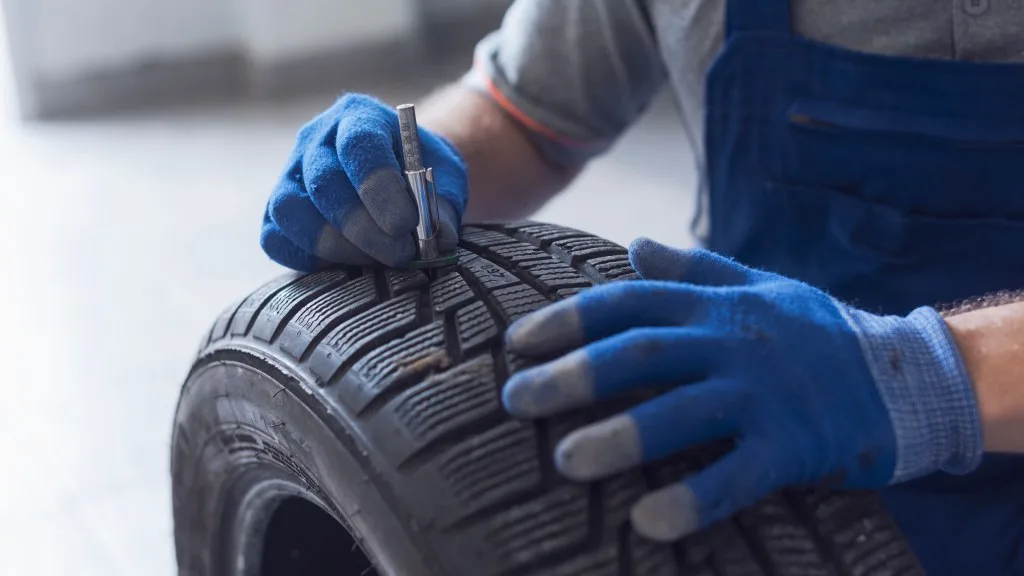Your tires are pivotal in keeping you and your vehicle on the road, and checking your tread only takes a few minutes. But doing so can help you avoid a major disaster down the road.
However, too many drivers hit the road without thinking twice about checking their tires.
Today, we’re sharing how the RV penny rule will help you avoid trouble.
Let’s jump in!
What Is an Easy Way to Check Tread on a Tire?
If you’re concerned your tire tread is wearing thin, you can take your vehicle to a reputable tire dealer. These shops will often take the necessary measurements of your tires and let you know if it’s time to replace them.
This standard measurement is typically taken during most oil changes to help drivers avoid getting caught off guard when it’s time to buy new tires. However, you don’t need to take your vehicle to a professional to check your tire tread.
Tires often have wear indicator bars built into the tread grooves. These bars measure 2/32”, and you need to replace your tires once the tread reaches these bars. You can also purchase a tread depth gauge, which is the most accurate way to measure your tread depth.
This is what the local tire store or mechanic will use to measure your tires. They’re relatively inexpensive, easy to use, and very accurate.

However, if you don’t want to waste money on a tread depth gauge, you can check your tire tread using a penny. Take the penny and place President Lincoln’s head upside down into the tread groove. If you can see Honest Abe’s head, immediately get to a tire shop.
However, if his head is covered, you have more than 2/32 of an inch. Just be sure you continue to check your tread regularly.
Also, RVs vary greatly with tire needs. A motorhome and a tiny travel trailer have significantly different tires. The penny test is a simplified test for generic tires. Read the needs of your own RV tires to make sure the penny test is applicable.
Pro Tip: Use these tips on How to Easily Patch a Tire Hole in case of emergency.

Is the Penny Test for Tires Accurate?
The penny test is a relatively accurate way to check a tire’s tread. However, a tire can pass the penny test and still be below 4/32 of an inch. This is typically the point where drivers begin to experience safety and performance issues with their tires.
It’s better to replace your tires before you experience issues than to risk your safety and other drivers. Get a tread depth gauge or stop by a tire shop when in doubt. This is typically a free service they will offer in hopes that you’ll return to purchase your tires from them.
How Do You Know if the Tread on Your Tire is Bad?
The only way to know if the tread on your tire is low is to measure it. If you’re not checking your tread regularly, you’ll eventually experience performance issues with your tires. This can pose a safety concern and cause a dangerous situation for you and others on the road.
Invest in a tread depth gauge, do the penny test, or find a reputable tire shop to measure your tires. Checking your tires takes only a few minutes and is something you should do regularly.
How Do I Know if I Need New Tires?
There are several signs that you need new tires, one of which is the tread depth. If your tires have reached the wear bars on your tires, it’s time to replace them. However, there are many more signs that it’s time to buy new tires.
For example, tire tread can develop bulges, gouges, and cracks over time, so check for that regularly. Tires are made from rubber and can develop blemishes as they age. If you see any of these signs, take your vehicle to a tire shop immediately.
Another obvious sign that it’s time for new tires is a change in tire pressure. It’s important to note that tire pressure often drops when cold temperatures arrive in the fall. This can cause your low tire pressure light to illuminate.
However, if you’re noticing that your tires are regularly losing tire pressure, it’s a sign of an issue. There’s a good chance you picked up a nail or some other object in one of your tires.
Tires that have reached the end of their life will also develop a vibration. This is often due to uneven tread wearing, making it feel like the vehicle is out of alignment. Have a mechanic inspect your vehicle if you feel the steering wheel vibrating as you travel down the road. You may need an alignment or a new set of tires.
How Many Miles Should Tires Last?
The number of miles you can expect from a tire will greatly depend on the quality of the tires. Most tires will last anywhere from 30,000 to 60,000 miles. However, there are a tremendous amount of factors that can significantly shorten the life of a tire. Where you live, the road conditions, and your driving habits can all play a major role in the life of your tires.
Just because you haven’t reached the expected mileage on your tires doesn’t mean they’re still in good condition. Rubber is a key ingredient in most tires, and it is prone to issues with age. Exposure to extreme heat and UV rays from the sun can dry out the tire and cause it to develop cracks.
As a result, a tire with a 50,000-mile rating may only last a few years even if you’ve only driven 20,000 to 30,000 miles on it.
Do RVs Need Special Tires?
Many RV tires use trailer tires, which have a thicker and stiffer sidewall than a standard passenger vehicle tire. This helps them carry heavier loads and handle the constant changes in movement and angles when towing.
RV tires don’t transfer power to the road or help with steering. They go where they’re towed.
The type of tire for your RV will vary based on the size and weight of your RV. A travel trailer will have a much different tire need than a large motorhome. Check to be sure you’re getting the right tires and tread for your RV, or you could be making an expensive mistake.
Pro Tip: We took a closer look at Do All Types of RVs Need Special Tires? Find out the truth!

How Often Should RV Tires Be Replaced?
As we said earlier, tires typically have a mileage rating ranging from 30,000 to 60,000+ miles. It could take decades for the average RV user to put that amount of miles on their rig. That’s a whole lot of weekend trips to the local campground.
That’s why a good rule of thumb is to replace your RV tires every three to six years, depending on where and how often you use your RV. If you live in desert-like areas with extreme heat, your rubber tires will dry out substantially faster than in other parts of the country.
How Much Is a Set of 4 Tires?
Costs for tires will depend greatly on the type and size of the vehicle, but also the quality of the tire you’re buying. Replacing all four tires on a compact vehicle will typically cost anywhere from $400 to $750. However, replacing all four tires on a big, beefy diesel truck can easily cost $1200 to $1800. A set of quality trailer tires for an RV will typically cost $600 to $850.
While it may be a tough pill to swallow, it’s much easier considering the risks of driving on tires past their prime. Tire blowouts can cause serious accidents, which can cause thousands of dollars in damage to your vehicle and other vehicles on the road.
If the accident is serious, you could also end up with medical bills or a lawsuit on your hand. Some RVers have had major tire failures that have nearly totaled their rigs. Those who use their rigs for full-time traveling and find themselves in this situation are in quite a pickle.
How Often Should I Check My Tire Tread?
We’re not mechanics or experts, but the National Highway Traffic Safety Administration is. They recommend that you check your tire tread every month. Don’t just check the tire tread depth; inspect the whole tire. Look for any obvious cracks or blemishes in the tire, even if your tires are brand new.
Tire manufacturers aren’t perfect, and the quality control department can miss some imperfections. Checking your tires regularly maximizes safety and helps ensure you and everyone else on the road are as safe as possible.
Discover the Best Free Camping Across the USA
To be honest with you, we hate paying for camping. There are so many free campsites in America (with complete privacy).
You should give it a try!
As a matter of fact, these free campsites are yours. Every time you pay federal taxes, you’re contributing to these lands.
Become a FREE CAMPING INSIDER and join the 100,000 campers who love to score the best site!
We’ll send you the 50 Best Free Campsites in the USA (one per state). Access the list by submitting your email below: